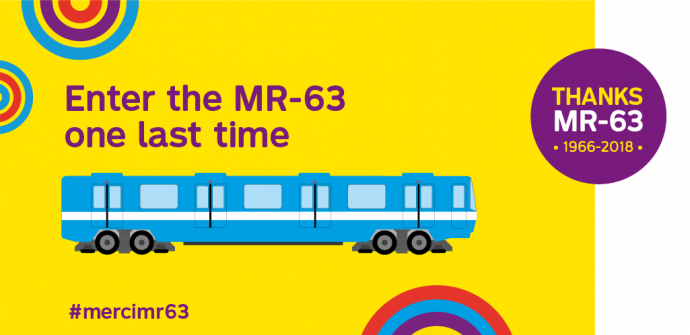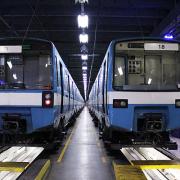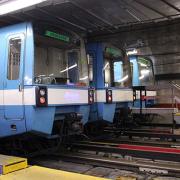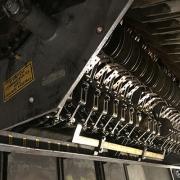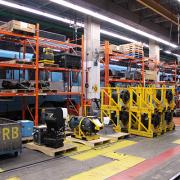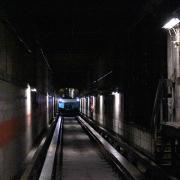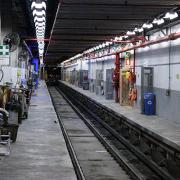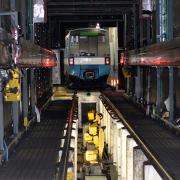The MR-63 métro cars — rolling stock designed in 1963 for the opening of the initial métro system in 1966 — will soon be a thing of the past.
The MR-63 métro cars — rolling stock designed in 1963 for the opening of the initial métro system in 1966 — will soon be a thing of the past as they will be replaced by the AZUR cars. The last original train will transport its last passengers in the week of June 18, 2018, before being permanently withdrawn from service.
This moment marks the end of an important chapter in the history of the Montréal métro and the STM. For 52 years, 333 MR-63 cars have moved hundreds of thousands of people everyday, chalking up more than four million kilometres each. To pay tribute to this first generation of trains, you are invited to visit the Beaugrand garage-workshop where minor repairs to the cars were carried out for over 35 years.
This moment marks the end of an important chapter in the history of the Montréal métro and the STM. For 52 years, 333 MR-63 cars have moved hundreds of thousands of people everyday, chalking up more than four million kilometres each. To pay tribute to this first generation of trains, you are invited to visit the Beaugrand garage-workshop where minor repairs to the cars were carried out for over 35 years.
The Beaugrand garage-workshop was built as part of the eastern extension of the Green line in 1976. Installed under a park to the north of Honoré-Beaugrand station, the new workshop was initially intended for minor maintenance of the second generation of cars, the MR-73. At the time, minor maintenance of the MR-63 cars was carried out at the Youville workshop, near Crémazie métro station.
With the extensions to the system and the expansion of the Youville workshop in the early 1980s, the two generations of cars were switched around and minor maintenance of the MR-63s was transferred to the Beaugrand workshop. Since 1966, major maintenance on all cars has been carried out at the Youville workshop.
Minor maintenance of métro cars includes a visual inspection every 10,000 km travelled, preventative replacement of certain parts according to mileage, inspection and changing of tires, removal of dust from bogies, as well as cleaning of the inside and outside of the cars.
With the progressive arrival of the AZUR cars, whose minor maintenance is carried out at the newly renovated Youville workshop, minor maintenance of the MR-73 cars has been gradually transferred to the Beaugrand workshop, which heralds a sort of home-coming for this rolling stock.
There is no major difference in the minor maintenance of the MR-63 and MR-73 cars, with only a decade separating these two generations of rolling stock. Most markedly, the technology of the MR-63 cars is entirely electromechanical, whereas the MR-73 cars include some electronic components.
You are invited to join Martin Lemieux, Beaugrand workshop superintendent, and Carl Arseneault, rolling stock maintenance director, for a tour of the workshop.
The five workshop inspection pits enable maintenance employees to verify the underneath of the métro cars, in particular their traction system. This is where you can get a close-up of the MR-63’s main defining component: the cam-operated switch, or the RX starting switch.
The RX starting switch is an electromechanical cam device that allows the current supplied to the motors to be regulated so that the train can start smoothly and reach its maximum speed. It consists of a 26-position rotary camshaft, driven by a small electric motor. In each position, mechanical switches are activated to add or withdraw resistors from the circuit supplying the motors. Basically, when the train starts the resistors are withdrawn one by one, which gradually increases the speed of the motors, hence the speed of the train. This tried and tested device (we are talking about pre-Second World War technology here!) does have the disadvantage of releasing a lot of heat when the train starts up.
That is why during the design of the second generation of rolling stock, the MR-73, the chopper was chosen. It works on the same principle as the RX starting switch but instead relies on electronic switches called thyristors. As a bonus, the MR-73’s choppers emit a little melody (doo-doo-doo) that corresponds to their various switching frequencies. In comparison, the RX starting switches just make knocking sounds (tock, tock, tock…). The AZUR trains, however, use a more recent technology composed of variable-frequency drives. This technology does not play a little tune (but the “doo-doo-doo” sound was kept as the door closing signal).
While the Montréal métro tunnels are very clean, there is still a significant amount of dust, which comes mainly from the friction of various parts of the métro cars, the tracks and guide bars (which supply electricity to the cars).
A special train (tunnel cleaning train) runs from time to time in the system, but it isn’t enough. The underneath of the cars must be blown regularly, otherwise various parts risk malfunctioning. Beaugrand is the only workshop to house an automated dust-blower designed especially for this job.
The MR-63 in numbers:
- Original order of 369 cars: 123 trailer cars numbered 80-0001 to 80-0123 and 246 motor cars numbered 81-1501 to 81-1746 (the third figure in each number was removed in the early 1970s)
- Designed in 1963 by the firm Jacques S. Guillon & Associés
- Delivered between 1965 and 1967 by the firm Canadian Vickers at a cost of $45.5 million
- 24 cars were destroyed in the fire of December 9, 1971
- 9 more cars were destroyed in the fire of January 23, 1974
- 3 cars from the former Jeumont train (used to test the chopper of the MR-73 cars) were removed from service prematurely
- Final number of MR-63 cars: 333
- Distance travelled by each car since 1966: more than 4 million kilometres
- Empty weight: 27,000 kg for a motor car and 20,000 kg for a trailer car
The Beaugrand workshop in numbers
- Cost of the garage-workshop in 1976: $7.2 million
- 12 managers
- 150 union employees
- Engineering and planning group support
- 5 tracks for scheduled and corrective maintenance, plus 3 on-track service pits
- 5 specialized tracks:
- automated dust blower
- washing ramp
- lifting tracks
- test tracks
- In operation 24 hours a day, 7 days a week
